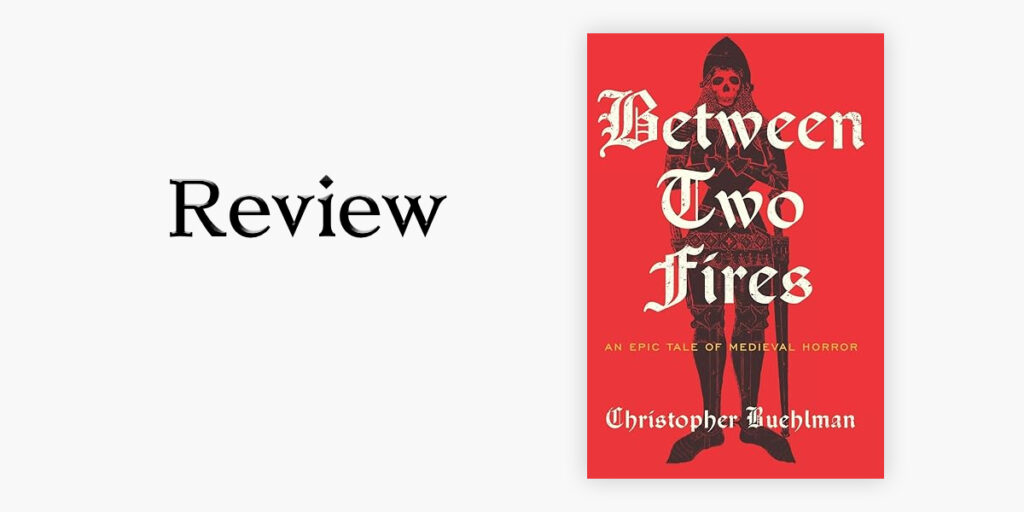If you know me, or if you’ve spoken to me for more than ten minutes, then you’ll know how highly I regard David Gemmell’s writing. I even listed his debut as one of the books that made me. His back catalogue is an absolute treasure-trove for fantasy fiction fans and I strongly encourage you to explore it all.
But for this post I want to zone in on some particular favourites of mine, and arguably the greatest Gaelic-inspired fantasy series ever written. The books of the Rigante. A four-book series that are separated (chronologically) by a few centuries of time, but weave together to create one of the greatest works of fiction ever produced.
Book 1 (Sword in the Storm) and Book 2 (Midnight Falcon) take place in a more ancient part of the history of the fictional Rigante clan (think the Iron Age) and Book 3 (Ravenheart) and Book 4 (Stormrider) leap forward to a time of muskets and dashing cavalry charges. Four books. Many centuries. A cast of incredible characters and a fantasy world unlike any other. Let’s dive in.
Warning: some spoilers ahead (although I’ve tried to keep as much of it vague, where possible)
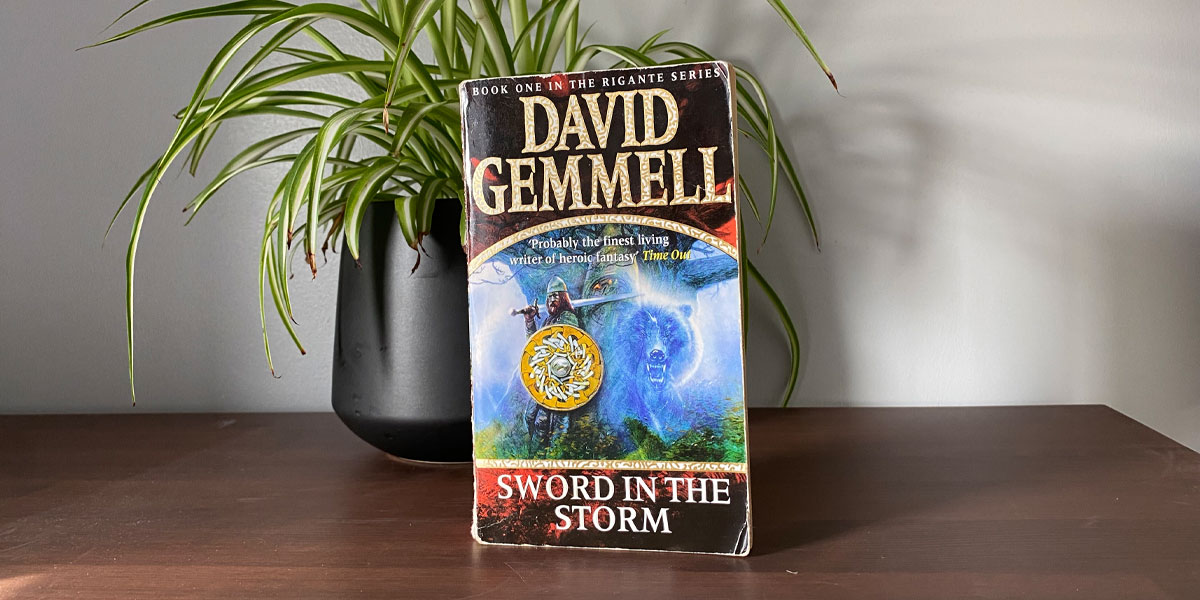
Sword in the Storm
For some context, the Rigante books borrow heavily from Gaelic (Scottish/Irish/Manx) mythology. The Rigante themselves are a fictional Celtic clan of tribesmen who have a close connection to nature, and strong notions of honour and the common good. They live in the mountainous region in the north of an island territory, the presumptive equivalent of ancient Scotland.
Sword in the Storm is an incredible introduction to this world, and to the characters who occupy it. We follow the adventures of Connavar (whose Rigante ‘soul-name’ is the titular Sword in the Storm) as he grows from a headstrong boy into a powerful, influential young man.
Connavar is the epitome of the struggle that lies at the heart of the human condition, and his story is Gemmell’s close examination of it. That struggle being our capacity (as humans) for bringing both great love into the world, but also great suffering, too. Early in the story, the young Connavar is forced to defend his disabled friend Riamfada as a wild bear attacks them, armed with just a dagger and his courage. Connavar is badly wounded and it is broadly assumed he will die as a result.
This—along with his rescue of a fawn in a magical, forbidden forest—is a defining moment in Connavar’s life, as his betrothed—fearing a life alone—abandons him on his deathbed. Connavar is left not only with the physical scars from the encounter, but he is emotionally devastated at what he perceives to be a betrayal. This creates a deep well of resentment and anger in our protagonist, which makes for a compelling character to follow throughout the story.
And the story itself rapidly expands from Connavar’s hometown of Three Streams. The young tribesman embarks on travels to mainland “Europe” where he eventually finds himself in the service of Jasarray (based on Julius Caesar) and the armies of Stone (Rome). Connavar rightly predicts that the Empire of Stone will never be content with just swallowing the lands and peoples of the mainland, and he fears for his own tribe who—apart from banding together to defeat viking-esque raiders, or to skirmish against close neighbours—are largely peaceful.
So Connavar returns home to begin preparing the Rigante for an eventual invasion. His dual-sided personality is once again put to the test and great tragedy strikes. Gemmell’s writing is so good that you feel every emotion, without the need for overly ostentatious prose or reams and reams of internal monologuing. He is the master at what I respectfully call “popcorn fantasy fiction” – it’s digestible reading, but no less cinematic or impactful for it.
The book culminates in the heroic deaths of more than a few great side characters, as well as the birth of Connavar’s bastard son (who is connected, through no ill of his own, to the aforementioned tragedy). A Stone army is, for the first time, defeated in battle. But Connavar knows that they have only bloodied the nose of this new threat.
The scene is set for a sequel…
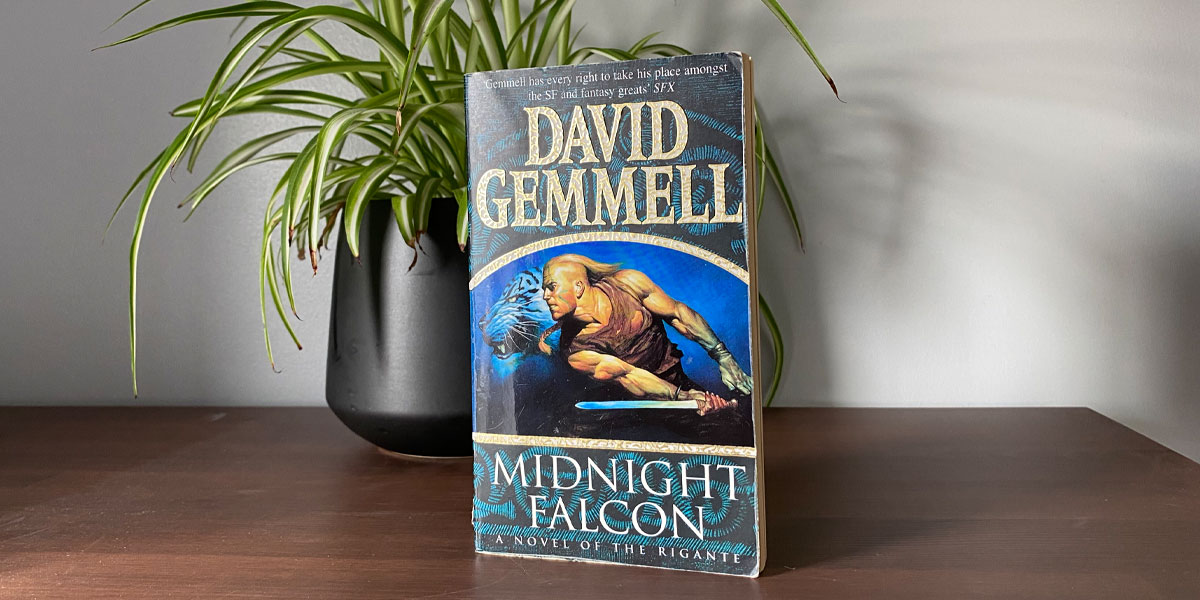
Midnight Falcon
Midnight Falcon is the second instalment in the Rigante series, and it takes place just under two decades after the events of Sword in the Storm. The book follow’s Connavar’s bastard son, Bane (whose soulname is Midnight Falcon – are you seeing the pattern of the titles here?) who demonstrates all of the key parts of his father’s personality. He is courageous and strong and capable of bringing joy to the world, but also quick to anger and ruthless in his actions.
The dynamic in this book is even better than in Sword in the Storm, largely because we’re already introduced to the older members of the cast of characters (Connavar’s friends [and enemies] from the first book) and so they provide a rich backdrop to Bane’s story, which has a new set of brilliant characters, too.
And then there’s Bane’s story itself. Again, like his father, he chooses to leave Rigante lands and see what the Empire of Stone is all about, accompanying a half-Rigante friend of his to the capital city, Stone itself. In yet another parallel to his father, tragedy strikes Bane and he is badly wounded by a brilliantly-written antagonist, the master swordsman and ruthless leader of the Knights of Stone, Voltan.
What follows is a plot-line that I’m almost certain helped inspire elements of Ridley Scott’s movie, Gladiator (I’m not 100% on the timings, but they seem to marry up).
Bane enrols in the arena as a gladiator, under the tutelage of the retired champion, Rage. All in the hope of challenging Voltan and exacting his revenge. This story takes place amid political turmoil in Stone, as a coup is mounted against Jasarray. The coup ultimately fails, leading to an epic final duel on the sands that will have you chewing your fingernails off as you read.
His lessons learned, Bane then returns to the lands of the Rigante, having decided to abandon his long-running hatred for the father who rejected him from birth. But more threats emerge and Bane is forced once again to take up arms, this time to defend his countrymen and women. Eventually, he is left with one last choice to make, which leads to a battle-scene finale that’s up there with the all-time best in fantasy fiction.
This also marks the end of the first era of the Rigante books, with books 2 and 3 picking up several centuries later, when the likes of Connavar and Bane are but myths and legends themselves.
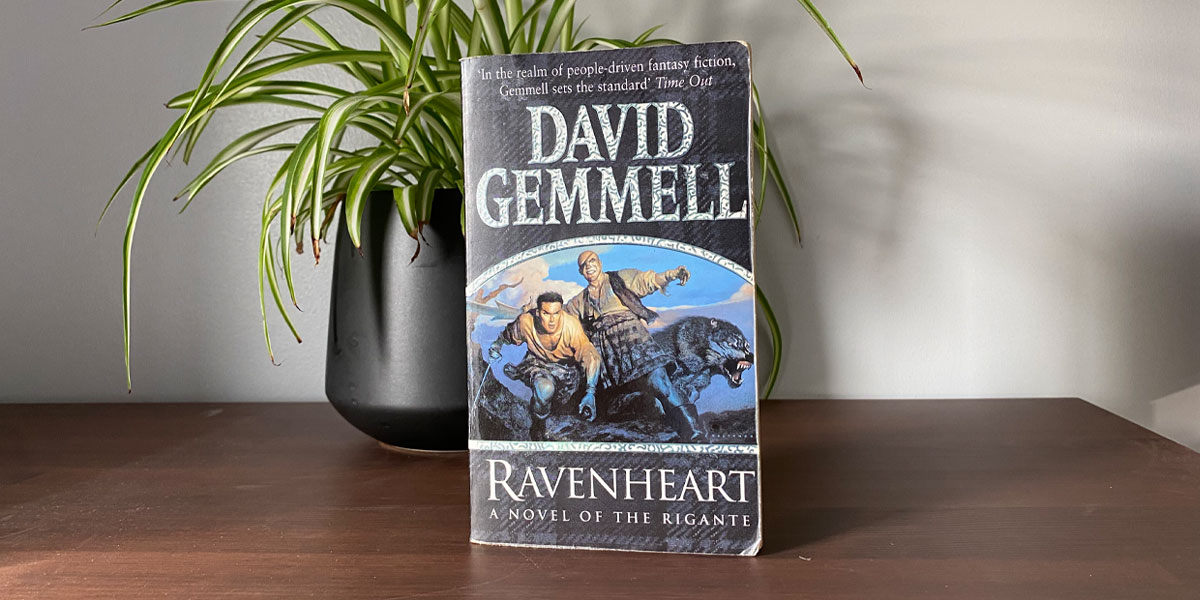
Ravenheart
So, first of all, these books are set several centuries after the events of both Sword in the Storm and Midnight Falcon. Connavar, his bastard son, Bane and all of their friends and loved ones are now the stuff of myth and legend themselves. Legends that are, in fact, being warped by some of the people we’re introduced to in these new stories.
Ravenheart follows our main character, Kaelin Ring (who is hinted as being a direct descendent of Connavar and Bane’s lineage). Kaelin is a young Rigante tribesmen living a subjugated life among oppressors known as the Varlish (i.e. the English). Specifically, Kaelin Ring is one of the subjects of the local lord, a wonderfully written character known only by his title, the Moidart.
In the book, Rigante tribesmen are “othered” by the Varlish, though the Moidart’s lands are far north enough that it is widely assumed that most Varlish families have “clan blood” in their lines, somewhere. Even so, the Varlish view the Rigante (and any of the clans) as beneath them, so much so that there’s even a declaration that twists Connavar himself into being a long-lost ancestor of the Varlish, and not the Rigante. This is just one snapshot into how well Gemmell writes the insidiousness of imperialism into these books, because the Varlish (much like the British Empire) absolutely love to rewrite histories to suit their own egos. In Ravenheart, the Varlish absolutely trample over the cultures of those they conquer, just like colonisers do in real life.
Kaelin shares the same hot-blooded temper as both Connavar and Bane do from the first books, and he is kept in check by two of the best secondary characters that Gemmell has ever written. In fact, two of the best characters that anyone has ever written in fantasy.
Jaim Grymauch is a larger-than-life tribesman who was friends with Kaelin’s father, a man who died at the hands of the Moidart in an opening-scene betrayal. If you’ve read Gemmell’s Drenai books, then you’ll see that there is a lot of “Druss” in Jaim’s character, but he’s also deeply infused with so much that’s magical about Celtic mythology. He is astute, but also straight-talking. He’s imposing, but not threatening (unless you mean him or others harm). There’s a certain kind of magic to him. And most of all, he embodies everything that’s great about being human, living harmoniously with nature, and simply being alive.
Maev Ring is Kaelin’s aunt, his dead father’s sister, and she is just as brilliantly written as Jaim is. She is a sharp-witted and quick-thinking female character who intimidates every single other character in this book, whether she knows it or not. She doesn’t need physical strength, or a warrior’s renown, to make her one of the strongest characters ever written. Her story, which in itself makes this book worthy enough, is an incredible arc and culminates in an absolutely heart-breaking final scene in front of a Varlish cathedral (IYKYK).
And that’s what makes this book so amazing. Kaelin Ring himself isn’t actually all that interesting as a character, and at first you might screw your nose up at yet another “coming-of-age MC” – but the reality is that this book stands up because of the surrounding cast of characters. Jaim Grymauch, Maev Ring, the Moidart, Kaelin’s Varlish schoolmaster Alterith Shadler, leader of the Black Rigante Call Jace, his daughter Chara Jace, all of them combine to make this an impeccable return to the world of the Rigante.
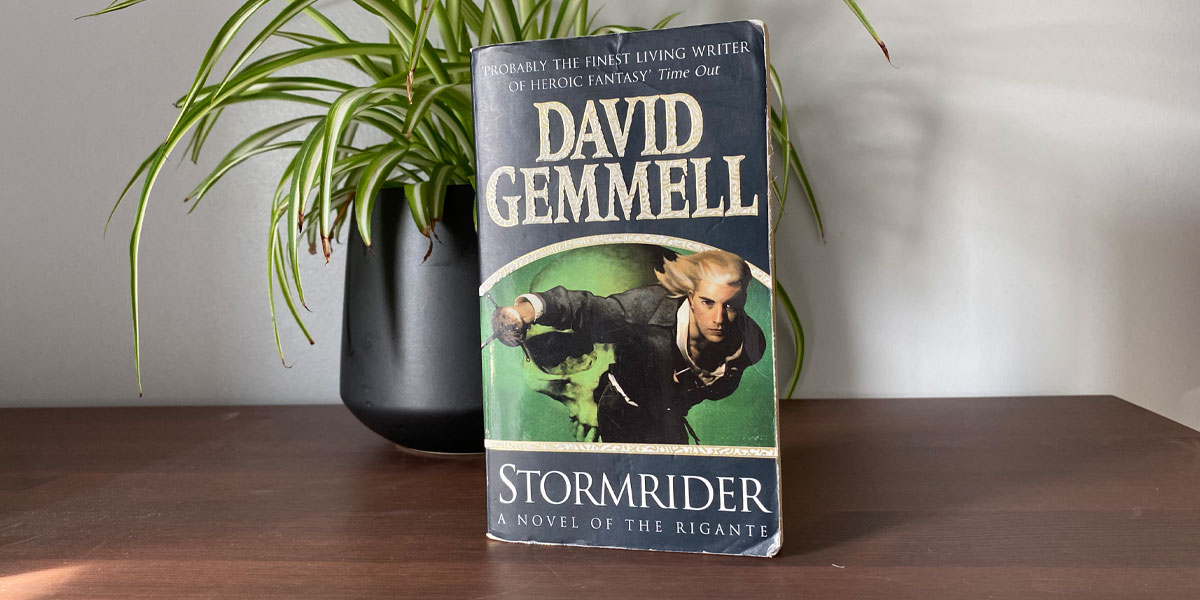
Stormrider
The fourth and final book of the Rigante series is a continuation of the events that take place in Ravenheart. Kaelin Ring, now with young children of his own, is a grown man, and the people of the Rigante are once again under threat.
This time though, the primary threat comes from a civil war brewing among the Varlish (akin to the Roundheads and Cavaliers fighting in actual English history). A rebellion against the monarchy is taking place, and the various lords and nobles are called to fight for the king. But, unbeknownst to them all, Winter Kay, the Lord Winterbourne, has been enthralled by an ancient power trapped inside a mystical skull. With this power, he seeks more than just a victory for his king—Winter Kay and his Redeemers seek dominion over all men.
Once again, Gemmell shows just how good he was at writing brilliantly fleshed-out characters and giving them some incredible stories to follow, too. The titular Stormrider is Gaise Macon, the soulname given to the Moidart’s estranged Varlish son. A dashing cavalry general who finds himself having to battle the same inner demons that Kaelin, Bane and Connavar all fought in their own stories.
Stormrider is arguably one of the weaker books in the series, but the standard is so high that it is still an absolute must-read if you like fantasy fiction, particularly of the Celtic-inspired variety. It is also a fitting end to the four-book series and it will leave you with that particular feeling that only truly great books can evoke. The feeling of being simultaneously overjoyed at having experienced such great storytelling and having been on such an incredible journey, but also innate sadness that the journey is now over.
Why you should read the Rigante books
The common theme across all of the Rigante books is Gemmell’s examination of the human condition. What makes good, good and what makes evil, evil? Who decides, and what part does perspective play in the matter? Can something be both good and evil at the same time?
Gemmell’s writing shows that there is both good and evil in all of us (a bear, chained inside of us, to use his own refrain) and he presents us with deeply flawed protagonists, time and again. Connavar, Bane, Kaelin and Gaise all battle their own chained bears, desperately trying to do good, while keeping the evil of their own human nature at bay.
This is the central theme of the Rigante series, and it’s one of the primary reasons I recommend them to any fantasy fan I meet.
The other reason is much more basic: these are four, wonderfully-written, beautifully-interconnected books, set in a Gaelic-inspired fantasy world that is both vast and intimate in equal measure. Four absolutely stellar works of storytelling. And when it comes to storytelling, David Gemmell was truly a master.
Gemmell brings rich, meaningful characters to life, without over-saturating them. Sure, some of the side characters feel a bit more wooden, but that in itself is a skill, because too much character-work can bog down good storytelling (after all, they’re “side” characters for a reason, it’s not their story!)
Gemmell also understands the need for a story to move at pace. Or, more importantly, he knows that the pace needs to change, as the story is told. Some sequences feel like they move at breakneck speeds, whereas others force you to mull over what’s happening a bit more – but it’s all by design and it all contributes to the overall experience. Even better, this makes Gemmell’s writing both brilliantly deep and amazingly easy to read.
The Rigante series are quick reads, but they’re far from shallow. They contain some of the best characters you’ll ever meet in the written word, and they help to deliver one of the best—if not the best—Gaelic-style fantasy series of all time.
📚✌🏻SP
Share this post
Steve Pannett is an author and designer based in Yorkshire, UK.
He writes primarily in the fantasy genre, combining character-led storytelling with epic, gritty world-building to create dark tales with plenty of action and lots of twists along the way.
He has self-published multiple books and is active online.


